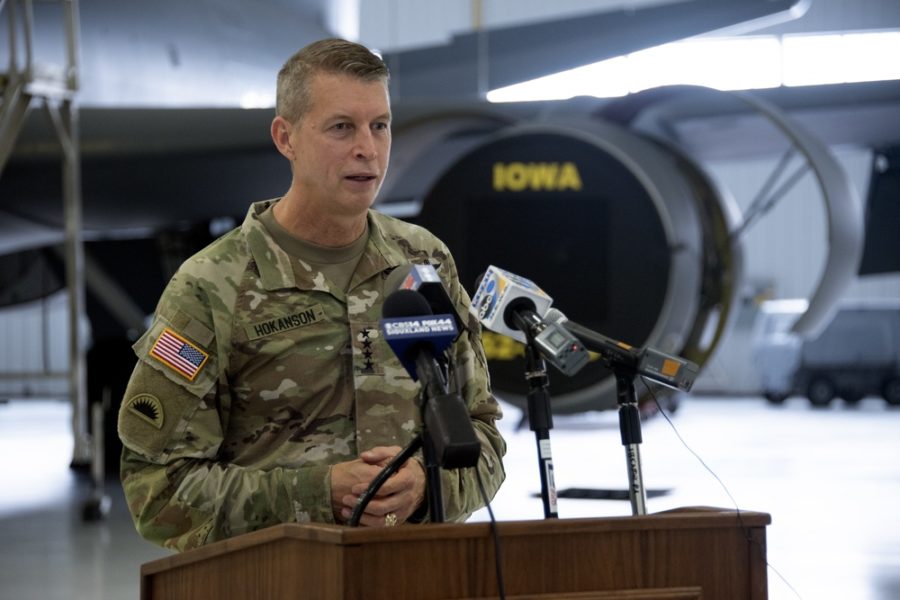The Air National Guard badly needs to modernize its fleet, not only for operations in the homeland but also for its warfighting mission, the head of the National Guard said Nov. 10.
Army Gen. Daniel R. Hokanson, chief of the National Guard Bureau, said the ANG’s “entire fighter fleet” needs to be modernized, with aging F-15C/Ds and F-16s swapped out for newer F-15EXs and fifth-generation F-35s.
“We want to … make sure that we have a pathway to modernization for each of our fighter squadrons because it’s an incredible capability,” Hokanson told reporters during a Defense Writers Group event in Washington, D.C. “But it’s also a capacity issue for our nation, to make sure that whatever we get asked to do, that we can do that.”
As of fiscal 2021, the Air National Guard had some 470 F-15C/Ds and F-16s, with an average age of over 30 years, compared to just 19 F-35s. Lt. Gen. Michael A. Loh, Air National Guard director, said in September that roughly 20 F-15Cs in the fleet were grounded because the backbones of the aircraft were cracked.
A number of Air National Guard units are slated to receive either the F-35 or F-15EX in the coming years. In 2020, the ANG announced that bases in Alabama, Florida, and Wisconsin would receive F-35s in addition to the Vermont unit that has already accepted them, while Portland Air National Guard Base, Ore., would get an F-15EX squadron. F-15C/D bases in Massachusetts, California, and Louisiana are set to receive one of the two new fighters.
But it’s not just fighters that need to be upgraded, Hokanson said. Increasingly, the Guard has been called upon to combat wildfires in the West, and to do so, several of its C-130s have been outfitted with the Modular Airborne Firefighting System (MAFFS).
With MAFFS, C-130s are able to drop 3,000 pounds of retardant on a wildfire in less than five seconds, fly back, refill, and be in the air again in under 20 minutes. But the system needs improvements to keep up with the increasingly high tempo required.
“We’ve got to make sure that we’re completely modernized so that they can perform the missions that they’re being asked to do. And when you look at firefighting, another piece of that is the MAFFS system. … It’s basically a series of pallets they push in the back of a C-130,” said Hokanson. “The Forest Service owns that, … [but] we also need to … continually upgrade those systems as well so they can perform as we need them, really, in the middle of the forest fires.”
The Air National Guard’s C-130H fleet is also being upgraded with a new propeller system to increase thrust and reduce maintenance hours. And in various versions of the 2022 National Defense Authorization Act, Hokanson noted several C-130Hs would be replaced by more modern C-130Js.
Replacements are good, but Hokanson wants to make sure there is no reduction in the ANG’s overall airlift capacity. In 2018, U.S. Transportation Command’s Mobility Capabilities and Requirements Study proposed that the Air Force needed 300 C-130s, a slight reduction from its current fleet size. A new MCRS was completed in June and has yet to be publicly released, but Hokanson said he hopes it will take into account the broad mission set of the Air Guard.
“In the past, it didn’t account for what we did in the homeland—that’s flying to forest fires, to disasters, and moving troops in a timely manner,” Hokanson said. “And so it’s supposed to be accounted for this year, and it will be interesting to see where it goes. I know right now we’re scheduled to have one of our C-130s come offline, in Mansfield, Ohio, and transfer to a different mission set. But we think the remaining aircraft is probably about what we need. But, of course, we need the data to support that. So we’ll watch very closely for that.”
Even beyond humanitarian and disaster relief responses, the ANG’s modernization needs to continue to boost the Guard’s operational effectiveness, Hokanson said.
“We really need the modernization for our warfighting mission. And if I can kind of just take a step back, that’s another thing that we constantly have to try and share, is that the whole reason the National Guard exists is the combat reserve of the Army and the Air Force, and we’re manned, trained, and equipped to fight our nation’s wars,” Hokanson said. “And when you look at the states, probably 98 to 95 percent of their budget is federally funded. So in that respect, we need the aircraft modernized so that they can be interoperable, no matter where we ask them to go on the globe.”
